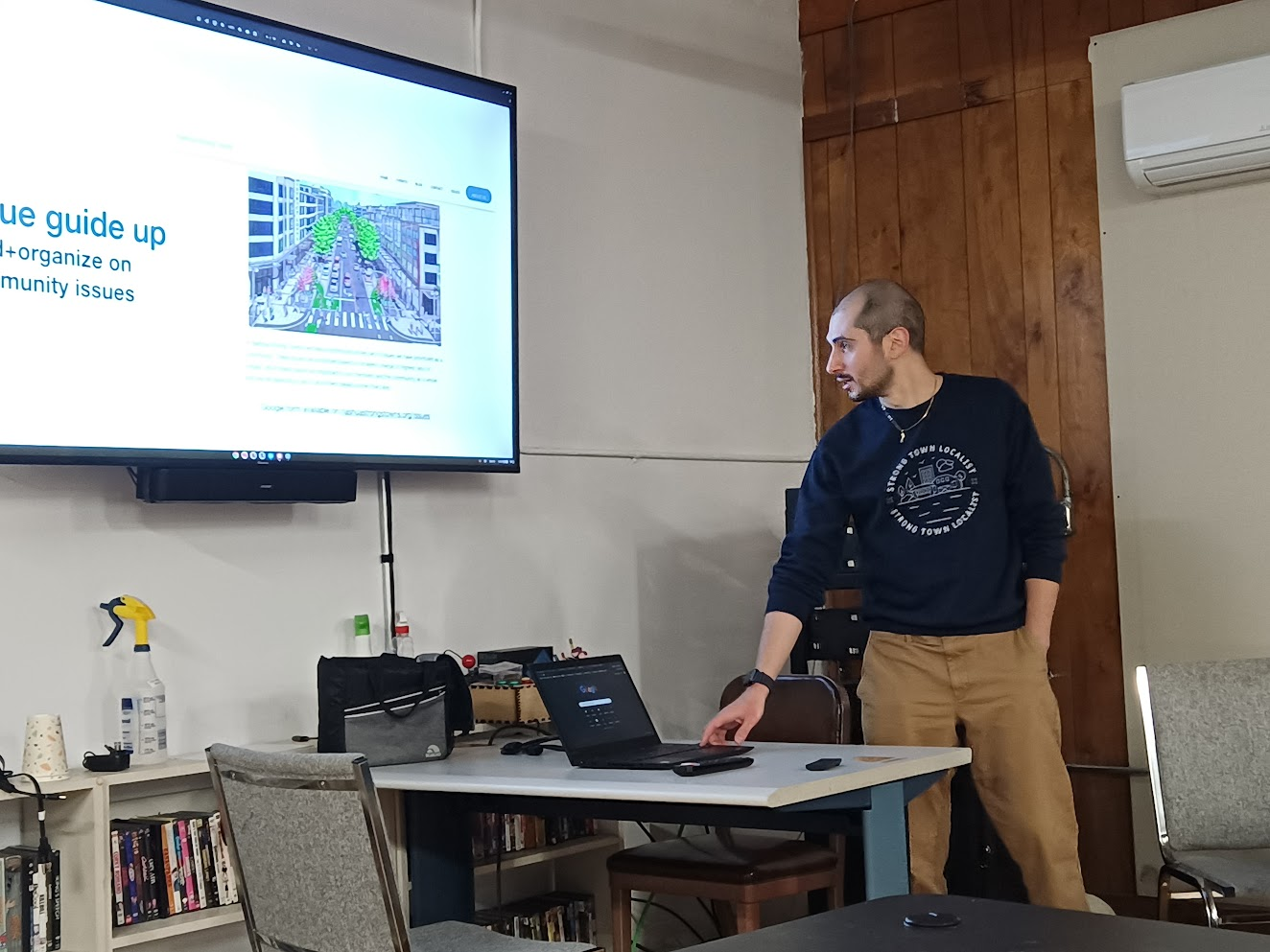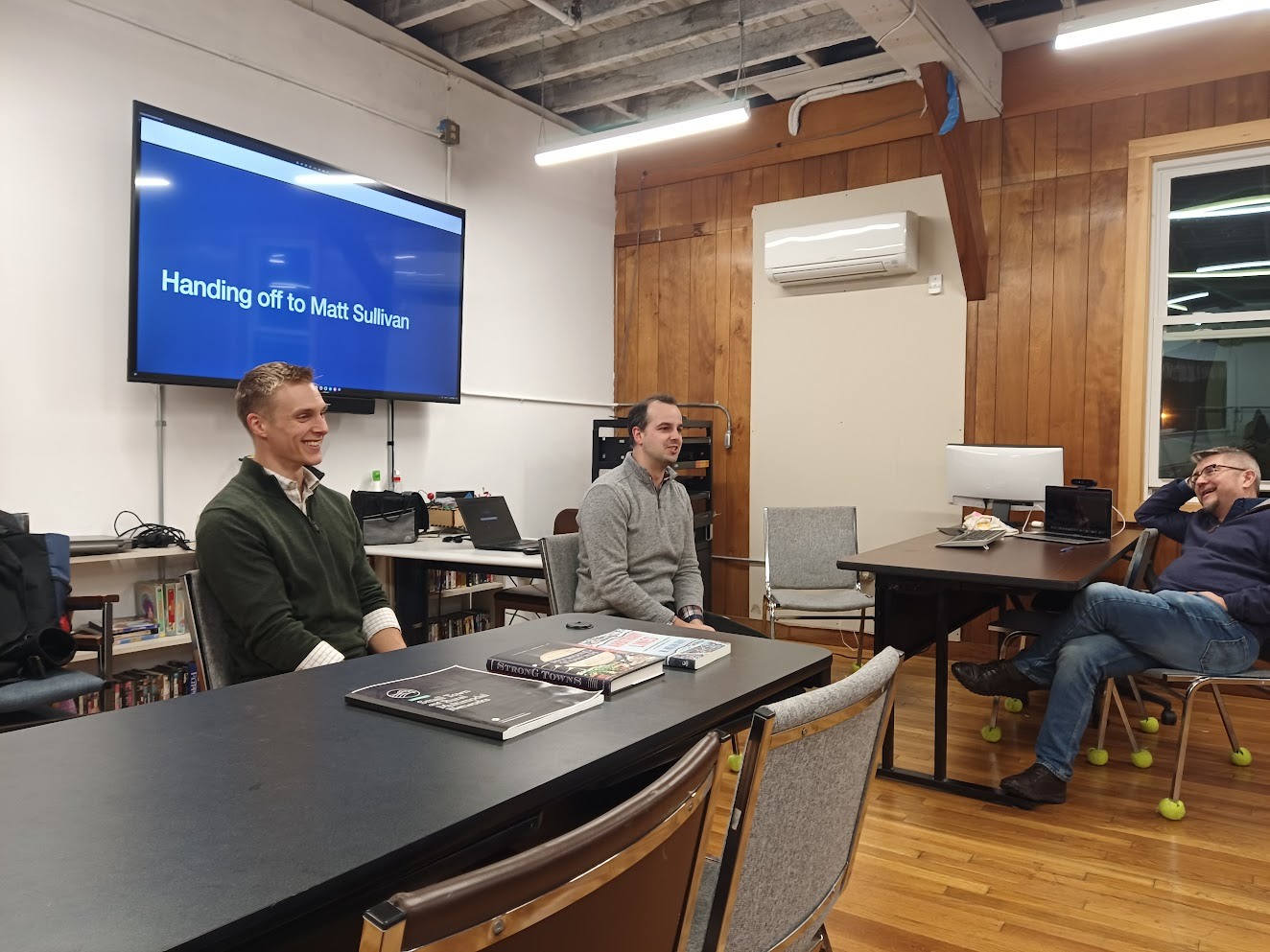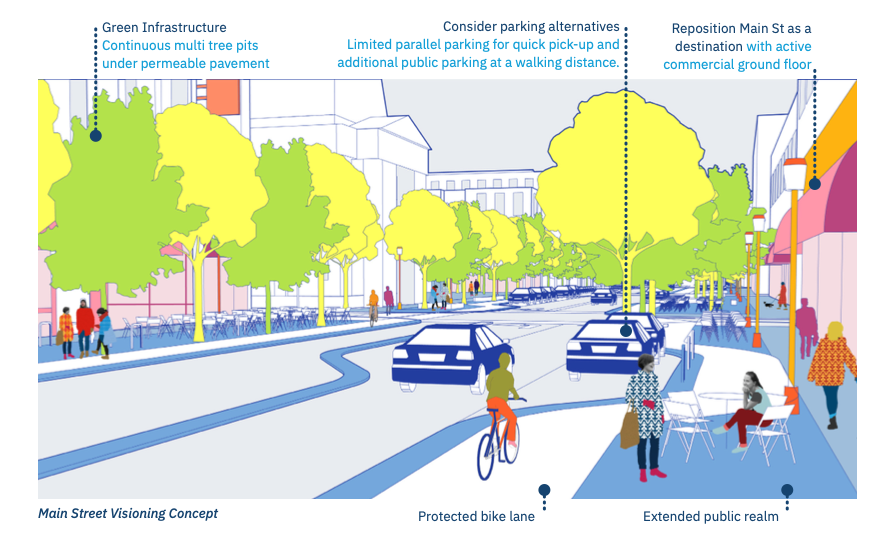Thanks to everyone who was able to make it to our third general Nashua Strong Towns meeting! It was great to have everyone here. This was our first in a couple of different ways. It was our first hybrid meeting! We made it possible for participants to show up virtually via Jitsi. It was also our first meeting where we had a speaker! Overall the turnout was quite good and we had some great conversations.
Meeting notes below

Stroll recap
We did a recap presentation of a number of things that have happened since the last meeting. The Nashua Stroll was a great success and it brought quite a bit of interest to our little group. We discussed the event and the fun survey we did of folks who came by our table. Detailed results can be found here.
Nashua Strong Towns mini library
We opened our “mini library” with books for members. If you come to a meeting and would like to borrow our Strong Towns – A Bottom Up Revolution, and Arbitrary Lines – How Zoning Broke the American City and How to Fix It you’re free to do so! Just talk with our Conversation Leader, Darrien Glasser at our next meeting if you’d like to read up for free!
Advocacy
Recent advocacy was a hot topic and we have been doing much work here.
Merrit Place
After a few planning meetings with a number of advocates showing up (some from Nashua Strong Towns, and some from other YIMBY groups in the area) the Merrit Place variances and site plans were approved. They may be challenged, but we have high hopes that everything will still swiftly be pushed through regardless.
The asphalt plant
The asphalt plant discussion is happening soon, on January 19th. We are looking to oppose the plant as it is bad for walkability in the area (emissions from the plant is most certainly not going to attract folks walking nearby), it is bad for the residents nearby who live in transitional housing, and it will most certainly not attract any businesses nearby. All in all it is a terrible proposition for the residents of Nashua who will not benefit from it.
Matt Sullivan also discussed a bit here – the asphalt plant and how the county is regulated for new developments. The state has to allow regulation for the communities. Communities can not add additional regulation on top of what the state allows.
One of the sticking points here is that the state can’t say yes or no to the development based solely on environmental concerns. It has to rely on criteria in the ordinance to make a decision.
Issue guide up
Now available at https://www.nashuastrongtowns.org/issues/ we have a community set of issues we have discussed and are working for to move the town forward. Each issue has its own template and will have the backing of Nashua Strong Towns member support. We regularly organize to help push them forward.
New Member guide in progress
We’re currently working on a new member guide to help folks who are interested onboard to the Strong Towns movement. Everything from understanding the basics of Strong Towns, to how to organize with us and be more active in the chapter.
The full presentation can be found below.
strong towns meeting 3Matt Sullivan and Sam Durfee – Q&A
After our general recap and announcements, we had both Matt Sullivan – Community Development Division Director of Nashua, and Sam Durfee – Planning Manager of Nashua both talk for a bit and have a general Q&A with the members of our Strong Towns community. It was great to have the two officials do community outreach and answer many of our questions! We’re looking forward to have more folks come in and talk at our meetings in the future.
Speech and Q&A paraphrased below:

Matt’s Intro
Matt began by discussing how community development is a very diverse field in Nashua. The job includes many different things including traditional planning, an urban program department which is granted federal funds for certain types of development, and the transit system (Nashua Transit System – NTS) which is an anomaly as most transit systems are not part of the planning department.
He went on to discuss how NTS being part of community development can be helpful as usage can be shaped around how land is used, making execution potentially more efficient as the two can work in tandem. NTS being part of community development also allows it to run more like a regional transit system rather than just a local one.
Some of the current challenges of NTS are that there is a general lack of funding making it difficult to expand it in a way that many residents would like. The driver market is also difficult to work around too, especially weekend trips where there are a general lack of drivers who would like to work on weekends.
Matt also mentioned here that some renewable energy was also under community development and mentioned Doria Brown working on aggregate electricity rates. Something that will lower electricity rates for residents still on Eversource in the coming months.
Matt mentioned some additional challenges that there are many fiscal constraints that can hamper transportation development. Transportation development funds include money for pedestrian/cycling infrastructure.
Sam’s Intro
Sam was given some time to talk next, discussing how he was rather new to planning in Nashua, joining only in August. He mentioned how he was introduced to planning in Nashua during a rather tumultuous time in terms of planning/development (many contentious issues like Costco development, Asphalt Plant, and Merrit Place).
Sam discussed how he was given time to work on the master plan and has done quite a bit of work talking about it with others.
The future of planning in Nashua
Matt and Sam discussed how land use may change in Nashua, although much of this is under debate and very much subject to change. Nothing is in stone, and in some cases hearsay. We want to be clear nothing here is official and rather just ideas that have come up in the planning department.
There was discussion here about how land use codes work in Nashua and how they are overly restrictive for both residents and developers. There was much talk about how zoning in the area may change from Euclidean Zoning to Form Based Zoning to give residents freedom they would like to use their own places of residence.
Currently in Nashua there is a general lack of places to live as the housing shortage grows in the area. The idea of densification of areas is now being brought up by more folks in a way that it has not in the past. Likely this will only affect areas that are already dense, allowing rural areas to stay rural, while providing more density to areas that are already dense.
One of the new apartment developments on Main Street is a good example of this, providing a large supply of market rate housing in an area that needs it.
Q&A
Here the many members of our local chapter of Nashua Strong Towns were given a chance to ask questions and discuss their concerns with Matt and Sam. Both questions and answers will be paraphrased.
How do we get more involved? How do we make a difference in the community?
Answered by Matt – The number one way to do this is to show up at town meetings. Many of these meetings are often slated in one direction, and having an opposing viewpoint with a few folks backing you up can be an enormous driver for change. Diversity in opinions is important.
It is important to reach out to your local aldermen/alderwoman too. Perhaps even to try and get them to a Nashua Strong Towns meeting if you’d like to introduce them to Strong Towns concepts.
What is the status of the Henry Hanger bike trail? When will it be finished?
Answered by Matt – The funding is there as well as the design and plans. The major blocker for the bike trail is that there are several locations where right of way is required to actually complete the trail. Construction may begin in late 2023.
How does Strong Towns affect your work?
Answered by Sam – after learning more about Strong Towns, Sam ensures fiscal responsibility when working on new projects. For instance, developers may often want to build new projects with water, sewer, and roads. Before moving forward with the project, the question is always asked: how does it get paid for? Ensuring the town does not overextend by assuming liability for things they cannot afford is a major contributor to many decisions made nowadays.
The high cost of infrastructure also changes how the planning board considers densification, or lack thereof. Running one mile of pipe for sewer to one house is inordinately expensive and may not pay for itself. Running one mile of pipe for sewer to a complex with 40 houses is much more likely to pay for itself.
This is not the only factor considered, but a new and important point of conversation when planning.
Main St – moving to 2 lanes were contentious, will we have to go through that every time we try to move back to 2 lanes?
Answered by Matt – 2 lanes on Main Street (rather than 4) was originally supposed to be a COVID only thing so folks would feel safe about eating outside. However this is something that the town would like to do again, not just because of COVID though. There is consideration around reshaping Main Street, but of course with such an important street both for automotive and pedestrian transport, there is much that has to be considered.
As the future of Main Street is considered, there will be community outreach, traffic studies, and more. Pedestrian impact will be considered as well of course.
– Some folks interjected here talking about the PAC may bring much new foot traffic to Main Street, so it is extra important to consider pedestrian safety and traffic to Main Street. Both officials agreed.
Matt and Sam went on to discuss that restaurants will likely have to pay if they would like to use street space for additional seating. If they don’t use it, this will potentially open up new opportunities for the land use that are not parking (food trucks were considered).
Could we get more “holiday strolls?”
Matt discussed how it is an enormous amount of work to shut down Main Street, but given the resounding success of the last Stroll, it is certainly something he would like to do.
– One of our members interjected and asked if perhaps we could have days where some of the side streets that are “less critical” to transportation are closed off to traffic for smaller events in the middle of the year. Testing small bets is something that is critical to Strong Towns. Matt said this would be considered.
When talking to other residents – should we consider discussing how higher density will lower tax burden?
Answered by both – it is something that is probably worth mentioning especially given the tax rate hike. It is not something many residents probably have thought about before.
Why is there no bus from downtown to Boston or to the Outlet Malls?
Answered by Matt – Route changes especially to businesses are subject to chartering restrictions. Moving to specific areas can be difficult (although this does not mean it does not get done, it just takes time).
As of now it is possible to get to Boston solely by bus, but NTS won’t take you fully there, you have to take the NTS to the Boston Express. To go all the way to Boston on the NTS wouldn’t be feasible as it would be in competition with the better funded Boston Express.
Why can’t we have the Boston Express show up in downtown Nashua?
Answered by Matt – this isn’t something I’ve considered. I will bring it up in a meeting later.
Why are there no Sunday buses?
Answered by Matt – this is something we’d love to do, but lack both the funding and the labor to do it. It is unfortunately difficult to even run on Saturday, but something we are committed to.
Why is there no shade/cover over bus stops?
Answered by Matt – This is a matter of both funding and in some cases land use. Funding for the NTS is far too low to afford bus shelter shade, but also in some places we don’t have proper permits to add shelter on bus stops.
Why is there free parking in garages in December, but NTS rides are not free?
Answered by Matt – We would love to be able to provide free NTS, but we have a difficult enough time funding it properly as is. With that said we have been exploring free NTS ride passes for workers on Saturday, as it is difficult for many of them to get to their jobs otherwise.
On the topic of the bus, Matt also wanted to add a few extra points – Like many other transit systems, our ridership is currently at 53% compared to pre-pandemic levels. This makes it even more difficult to fund. Our buses are clean, comfortable, and great for the environment. If you have the ability to ride a bus to get somewhere and it lines up with your schedule, please do! The more ridership there is on the bus, the better we’ll be able to advocate for expansion/more rides.
The bus goes until 10PM and has bike carriers.
One of our members then challenged everyone to take the NTS to our next meeting (likely some time in mid-late January). All routes can be found here and it is absolutely something we (Nashua Strong Towns) will try to make as easy as possible to for folks to do at our next meeting.
What is the status of commuter rail in Nashua?
Answered by Matt – The commuter rail plan has changed a few times. Currently Manchester + Nashua are the priorities for the commuter rail. Nashua would get two stations, one near downtown, and one near the malls. According to current calculations, the commuter rail would actually run at a profit which is both unexpected, but good news for Nashua rail.
How it would currently work if the rail were implemented:
- The state would handle uptake on operational of the rail line
- The city would take on station maintenance+building
We are serious with regards to constructing commuter rail, but much of it is contingent on whether or not we get the federal funding for it.
The MBTA is also an authority on whether or not the line would actually get built as well. There is still some discussion that has to be completed with the MBTA. There are also questions on where the overnighting station will be.
With all that said, the state is pushing for rail, and it’s possible make some strong progress in early 2023 after getting some more financial data.
As the town is committed to Transit Oriented Development lots of new housing would likely be built near commuter rail stations.
Amherst St/Main St intersection is dangerous, how can we make this better for pedestrians?
Answered by Matt – this is a difficult question to answer. In order to make this intersection better we need to work on driving down volume in this area. It is a critical junction for folks going to Hudson and much other traffic.
This is something that will likely go up for community review. We will need support from the public for any major changes in this area.
The master plan is great – how do we keep up with developments in the master plan and make sure we show up to meetings to support it?
Answered by Matt – we recommend joining an alderman’s email list to see what new meetings are coming up. The town’s site UI is not the best, so it can be difficult to know what is going on otherwise.
Matt then recommended to either join ward 8 alderman’s email list (Derek Thibeault). All of the town alderman can be found here.
For more on the master plan, see the official site here.

Closing out
Those were all of the questions we had time for. The meeting lasted until around 8:45PM. We really appreciate both Matt and Sam making the trek out for our meeting and then spending so long with us chatting with our group. The meeting went over the scheduled end time by over an hour, and yet both were willing to stick around and answer each of our questions.
If you see them around, make sure to give them a hearty thanks as a Nashua Strong Towns member for taking time out of their day to talk with us.
1 Comment
General meeting #4 recap – trains and towns - Nashua Strong Towns · January 31, 2023 at 8:15 pm
[…] in Nashua is currently being evaluated, and based on our last meeting with city planners it is quite likely going to not only be good for Nashua residents, but also profitable. HB 110 stops […]